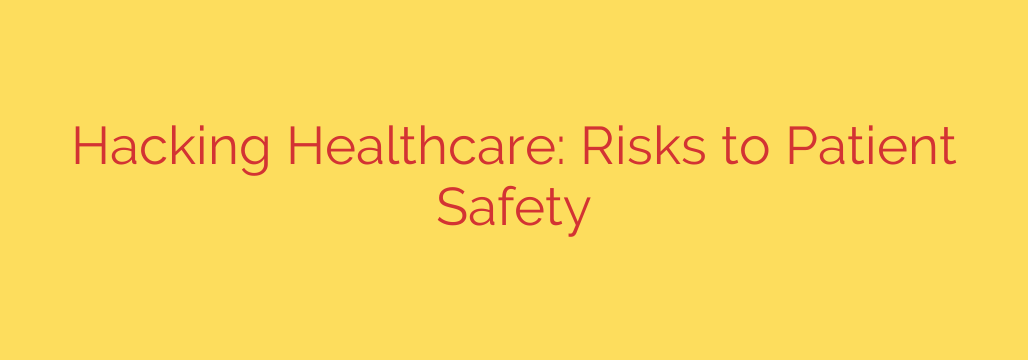
When Code Turns Critical: How Healthcare Cyberattacks Directly Endanger Patient Lives
In the modern world of medicine, the hum of a server and the beep of a connected device are as common as the stethoscope. Healthcare has undergone a profound digital transformation, with everything from patient records to life-sustaining equipment now part of a vast, interconnected network. While this evolution has brought incredible advancements in care, it has also opened a new and dangerous front: cybersecurity.
Today, cyberattacks on healthcare are not just about stealing data; they are a direct and growing threat to patient safety. The line between digital security and physical well-being has blurred, and a single breach can have devastating, real-world consequences.
The New Digital Battlefield in Medicine
Hospitals and clinics have become prime targets for cybercriminals for several reasons. They hold a treasure trove of sensitive information—from Social Security numbers to detailed medical histories—known as Protected Health Information (PHI), which is incredibly valuable on the dark web. Furthermore, the critical nature of their operations means they cannot afford downtime, making them more likely to pay a ransom to restore their systems.
This vulnerability is amplified by a complex web of technology:
- Electronic Health Records (EHRs): Centralized digital records are essential for modern care but also create a single point of failure if compromised.
- Internet of Things (IoT) Medical Devices: Pacemakers, insulin pumps, infusion pumps, and even MRI machines are now connected to networks, making them potential targets for hackers.
- Telehealth Platforms: The surge in remote consultations has expanded the digital “attack surface,” creating more entry points for malicious actors.
From Ransomware to Risk: Common Cyber Threats and Their Impact
Understanding the types of attacks is key to grasping the danger they pose. It’s not just sophisticated, state-sponsored hacking; often, the most damaging breaches start with a simple, preventable error.
Ransomware: The Digital Hostage Crisis
This is currently the most disruptive threat to healthcare. In a ransomware attack, malicious software encrypts a hospital’s files, rendering them completely inaccessible. The attackers then demand a large payment to restore access. For a hospital, this means doctors and nurses lose access to patient histories, medication lists, and allergy information. The result? Ambulances are diverted, critical surgeries are postponed, and patient care grinds to a halt.Phishing and Social Engineering
Many cyberattacks begin not with a complex hack, but with a deceptive email. Phishing attacks trick healthcare staff into clicking a malicious link or revealing their login credentials. This “human element” is often the weakest link in security, granting attackers unauthorized access to sensitive patient data and critical hospital networks.Hacking Medical Devices
Perhaps the most terrifying threat is the direct manipulation of medical equipment. Researchers have demonstrated the ability to remotely access and alter the settings on devices like insulin pumps and pacemakers. A successful attack could result in life-threatening malfunctions, such as an incorrect medication dosage being administered or a vital life-support device being shut down.
The Critical Consequences for Patient Safety
When a hospital’s digital infrastructure fails, the impact on patient care is immediate and severe. The consequences go far beyond a data breach notification letter.
Delayed or Canceled Treatments: When patient records are locked by ransomware, medical staff are forced to revert to pen and paper. This chaos leads to the cancellation of appointments, radiation treatments, and even urgent surgeries, putting patients with time-sensitive conditions at extreme risk.
Inaccurate Diagnostics and Care: Modern diagnosis relies on digital imaging and lab results. If a hacker gains access to a hospital’s network, they could theoretically tamper with medical scans or test results, leading to a devastating misdiagnosis and improper treatment.
Compromised Medical Equipment: As mentioned, a direct attack on a networked medical device can have fatal consequences. Patients rely on these tools to function correctly, and a malicious actor could turn a life-saving device into a weapon.
Loss of Trust and Data Integrity: Beyond the immediate physical danger, data breaches erode the fundamental trust between patients and providers. When sensitive health information is stolen, it can be used for fraud, identity theft, and blackmail, causing long-term financial and emotional distress.
Protecting Our Health: A Shared Responsibility
Securing healthcare is not solely the job of an IT department; it requires a coordinated effort from organizations, manufacturers, and even patients.
Actionable Security Tips for Healthcare Providers:
- Invest in Proactive Security: Implement a multi-layered defense strategy, including firewalls, endpoint protection, and regular security audits. Assume you will be targeted.
- Prioritize Staff Training: The human element is crucial. Conduct regular, mandatory training to help all staff recognize and report phishing attempts and other social engineering tactics.
- Develop a Robust Incident Response Plan: Don’t wait for an attack to happen. Have a clear, practiced plan for how to maintain patient care, communicate with stakeholders, and restore systems during a cyber incident.
For Patients:
- Be Vigilant: Be suspicious of any unsolicited emails or texts claiming to be from your provider. Never click on suspicious links or provide personal information.
- Use Strong Passwords: Use strong, unique passwords for any online patient portals and enable two-factor authentication whenever possible.
- Ask Questions: Don’t be afraid to ask your healthcare provider about the steps they take to protect your data and ensure the security of their medical devices.
In the 21st century, cybersecurity is a fundamental component of patient care. Safeguarding digital systems is as critical as sterilizing surgical tools. As technology and medicine become ever more intertwined, building a resilient and secure healthcare infrastructure is no longer just an option—it is a life-or-death imperative.
Source: https://www.helpnetsecurity.com/2025/10/13/report-cyberattacks-disrupt-patient-care/








